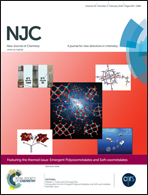Microwave-assisted synthesis of bovine serum albumin–gold nanoclusters and their fluorescence-quenched sensing of Hg2+ ions†
Abstract
This study presents the microwave-assisted synthesis of fluorescent bovine serum albumin (BSA)–gold (Au) nanoclusters (NCs). The as-prepared BSA–Au NCs exhibit red fluorescence (λem = 650 nm), large Stokes shift (300 nm), and high quantum yield (1.9%). Transmission electron microscopy revealed BSA–Au NCs to be well dispersed, with an average diameter of 2.1 ± 0.3 nm. By conducting energy dispersive X-ray spectroscopy, X-ray photoelectron spectroscopy, fluorescence anisotropy analysis, Raman spectrometry, and matrix-assisted laser desorption mass spectrometry, we confirmed that metallic Au NCs were successfully embedded in BSA. Because of the metallophilic properties of Hg2+ ions and Au+ ions, the degree of interaction between the ions induced fluorescence quenching, and thus the change in fluorescence at 650 nm was dependent on the Hg2+ ion concentration. Under optimal conditions (0.1 × BSA–Au NCs; 5.0 mM 4-(2-hydroxyethyl)-1-piperazineethanesulfonic acid buffer at pH 7.0), the limit of detection for Hg2+ ions at a signal-to-noise ratio of 3 was 2.98 nM. We used this nanosensor to determine Hg2+ concentration in environmental water samples (pond and seawater). This approach is advantageous because it is facile, accurate, and precise (the relative standard deviation of the three runs of each sample was less than 3%).


 Please wait while we load your content...
Please wait while we load your content...